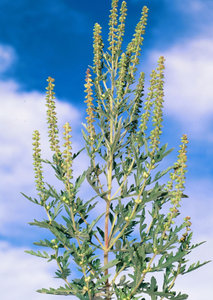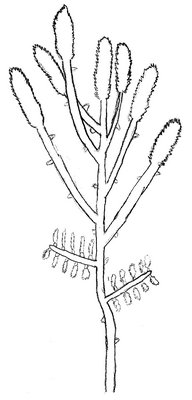Lakota names: caŋhlόgaŋ waśtémna means "sweet-smelling weed", caŋhlógaŋ oŋzipakiŋte means "weed to wipe the rear", poipiỵe means " to doctor swellings with." A tea from the leaves is applied to swellings. Listen to Lakota Plant Names: caŋhlόgaŋ waśtémna, c. oŋzipakiŋte, poipiỵe
Listen to Lakota Plant Names: caŋhlόgaŋ waśtémna, c. oŋzipakiŋte, poipiỵe
Scientific name: Ambrosia artemisiifolia
Common name: ragweed
Description: Small ragweed is in 46 states in the United States. It is most common in the Eastern states and the Midwest. The plant produces up to 1 billion pollen grains in a year. It usually grows in rural areas. People get allergies from ragweed. When people are allergic to ragweed pollen and they inhale its pollen from the air, the common hay fever symptoms develop. Seventeen species of ragweed grow in North America. 75 percent of Americans who have allergies are allergic to ragweed. Once a person is allergic to pollen they tend to develop other pollen allergies. To know if you are allergic to ragweed you have to have a physical exam and a skin sensitivity test.


Ambrosia artemisiifolia. © Steve Dewey, Utah State University.
Flowering: Flowers & Fruit: “Flower heads not showy, individually small, 2-5mm (1/12-1/5in.) across, green and inconspicuous but very numerous and forming distinctive inflorescences; individual florets either male or female, but never both; all flowers within one flower head either only male or female, but both male flower heads and female flower heads usually present on the same plant; heads of male (pollen-producing) flowers in raceme-like elongated clusters at ends of branches, each male head hanging downwards on a short stalk like a tiny inverted umbrella; female (seed-producing) flower heads in axils of short, narrow, green bracts near the base of each long cluster of male flower heads, each female head with only a single flower and producing a single, hard, somewhat triangular or diamond-shaped seed with several, short, sharp spines around the upper shoulder, the whole seed 3-5mm (1/8-1/5in.) long. Flowers from August to October.”
Similar Species: The Goldenrod, Solidago, is a similar species to ragweed.
Black hills distribution: This plant is found all over the state of South Dakota.
Habitat: It is in cultivated land throughout southern Ontario. It is also in gardens, flower borders, poorly kept lawns, edges of sidewalks, roadsides, fence lines, and waste places.
Secondary Plant Compound: Thiarubrine A.




 Go to quick links
Go to quick search
Go to navigation for this section of the ToL site
Go to detailed links for the ToL site
Go to quick links
Go to quick search
Go to navigation for this section of the ToL site
Go to detailed links for the ToL site